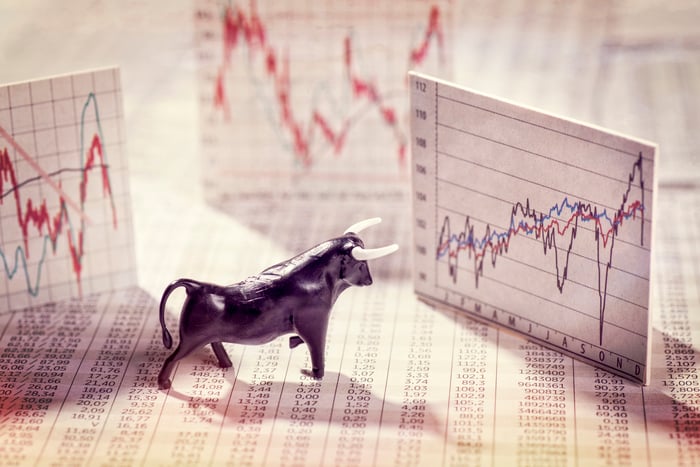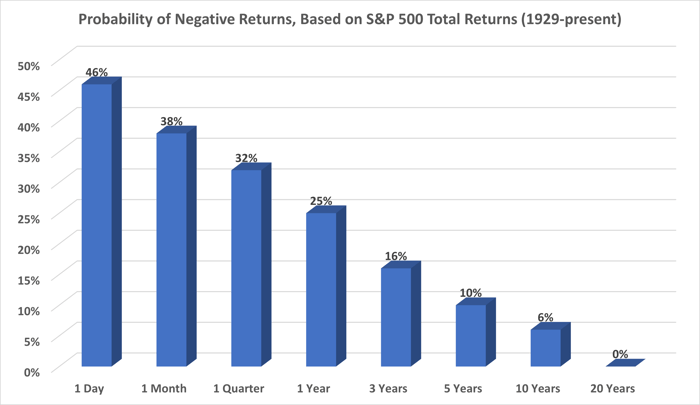4 Surefire ETFs to Buy in 2024 That Can Make You Notably Richer by 2030

[ad_1]
Last year was a rock-solid reminder of how powerful a wealth creator Wall Street can be. The 127-year-old Dow Jones Industrial Average ascended to a record high, while the broad-based S&P 500 (^GSPC -0.15%) and innovation-driven Nasdaq Composite tallied gains of 24% and 43%, respectively.
However, stock market corrections, bear markets, and even crashes are a normal and inevitable aspect of putting your money to work on Wall Street. For investors with less tolerance for risk, or who don’t have the time to devote to researching individual companies, exchange-traded funds (ETFs) can make a lot of sense.

Image source: Getty Images.
An ETF holds a basket of securities within a fund, but is traded like a stock on a major exchange. Depending on an investor’s risk tolerance, investing timeline, and financial goals, ETFs can be concentrated or diversified; be targeted at growth, value, or income stocks; and be focused on small-, mid-, or large-cap stocks.
With over 3,000 publicly traded ETFs in the U.S., and more than 8,700 globally, there’s a good chance an ETF is out there that’ll align with your financial goals.
With this being said, four ETFs stand out as surefire buys in 2024 that can, by 2030, make patient investors notably richer.
1. Schwab U.S. Dividend Equity ETF
The first phenomenal ETF that can really pad your pocketbook while growing your nest egg over the next six years is the Schwab U.S. Dividend Equity ETF (SCHD -0.53%). This fund tries to track the total return (including dividends) of the Dow Jones U.S. Dividend 100 Index.
Although growth stocks have received all the glory in recent years, dividend stocks have been collectively unstoppable for decades. Based on a Hartford Funds report in conjunction with Ned Davis Research, dividend stocks have delivered an annualized return of 9.18% between 1973 and 2022. Not only does this outpace the annualized return of the S&P 500 over this stretch, but it more than doubled the 3.95% annualized return of public companies that don’t offer a dividend.
As of Jan. 5, the Schwab U.S. Dividend Equity ETF had more than $76 billion in assets invested in 104 companies. These 104 holdings are primarily time-tested businesses that often have lengthy track records of sustaining profitability during downturns and maintaining or building on their existing capital-return programs. This ETF is 21% less volatile than the benchmark S&P 500, but is delivering more than twice the annual yield (about 3.6%).
Another reason investors can feel confident about buying the Schwab U.S. Dividend Equity ETF is its low net expense ratio, which describes how much you’ll pay in various fees to invest in a fund.
This ETF has a total expense ratio of just 0.06%, meaning you’ll owe only $0.60 in fees for every $1,000 invested. As your initial investment compounds over time, it means you’ll get to hang on to more of your money.
2. Vanguard Growth ETF
A second surefire ETF to buy in 2024 that can make you notably richer by the turn of the decade is the Vanguard Growth ETF (VUG 0.22%). This fund is trying to mirror the performance of the CRSP U.S. Large Cap Growth Index, and it has delivered an annualized return of 10.75% since its inception in January 2004.
As its name implies, this is a large-cap, growth-focused fund — and it certainly shows it based on its metrics. The Vanguard Growth ETF had nearly $192 billion invested across 221 stocks as of the end of November.
Although the aggregate of these holdings had a seemingly frothy price-to-earnings (P/E) ratio of 35.4, these 221 growth stocks also have an average earnings growth rate of 21.1%. When factoring in this superior earnings growth, the valuation becomes far more reasonable.
Something else to consider is the recent outperformance of growth stocks. A Bank of America/Merrill Lynch report released in 2016 found that value stocks had outperformed growth stocks on an annualized basis over a 90-year stretch (1926-2015) — 17% vs. 12.8%.
But thanks to historically low interest rates and a flurry of game-changing innovations and next-big-thing trends, growth stocks have turned the tables on value stocks and handily outperformed since the Great Recession. The Vanguard Growth ETF gives investors a way to capitalize on this trend continuing throughout the 2020s.
Investors should also be pleased with the ETF’s ultra-low net expense ratio of 0.04%. Since the turnover rate in this fund is rather low (just 5.4% in 2022), investors won’t be paying much in the way of fees. Furthermore, the roughly 0.5% yield more than offsets the minimal net expense ratio.

Image source: Getty Images.
3. and 4. Vanguard S&P 500 ETF and SPDR S&P 500 ETF Trust
The final two surefire ETFs you can buy in 2024 that can make you notably richer by 2030 are the Vanguard S&P 500 ETF (VOO -0.24%) and the SPDR S&P 500 ETF Trust (SPY -0.15%). The reason I’ve chosen to lump these two ETFs together is because they’re both trying to mirror the total returns of the benchmark S&P 500 Index.
As I pointed out earlier, stock market corrections are unavoidable for Wall Street’s major indexes. Since the start of 1950, data from Yardeni Research shows that the S&P 500 has undergone 39 double-digit-percentage declines. But with the exception of the 2022 bear market, it’s put the previous 38 double-digit drops in the rearview mirror. Over extended periods, the high-quality components that make up the S&P 500 push the index higher.

Data source: Bank of America Global Research. Chart by author.
A study published last year by Bank of America Global Research adds more fuel to the argument that buying and holding S&P 500 index funds like the Vanguard S&P 500 ETF and SPDR S&P 500 ETF Trust can be a winning strategy.
Researchers examined the probability of an investor generating negative returns in relation to the total returns of the S&P 500 since the beginning of 1929. Whereas a one-day holding period offered a 46% probability of negative returns, a five-year holding period reduced this probability to just 10%. Meanwhile, a rolling 20-year holding period in the S&P 500 has never produced a negative return.
The final reason these two index funds make for a smart buy is their minuscule net expense ratios. Although the 0.09% net expense ratio for the SPDR S&P 500 ETF Trust is quite low, the Vanguard S&P 500 ETF’s 0.03% ratio is even lower. The latter makes even more sense for investors who are putting big bucks to work in an attempt to mirror the performance of the S&P 500.
[ad_2]




